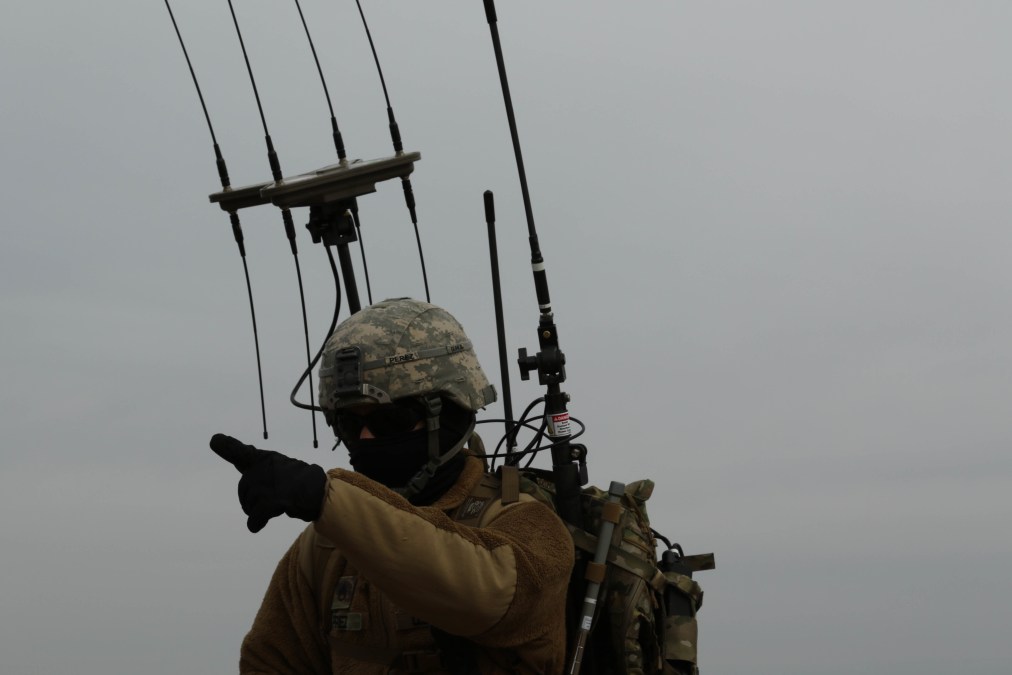MARK POMERLEAU

Staff Sgt. Kristoffer Perez, Cyber Electromagnetic Activities section, 1st Armored Brigade Combat Team, 1st Infantry Division, points toward a nearby objective during the final day of training with his section’s new equipment at Fort Riley, Kansas. (Photo by Sgt. Michael C. Roach, 19th Public Affairs Detachment)
The Army is now searching for an initial solution for a portable electronic warfare system, the first such program-of-record system in years.
“We recently, through our other transaction authority consortium, we released a request for white papers asking industry to come with a manpack solution for a small form factor, electronic attack and electronic sense capability,” Mark Kitz, program executive officer for intelligence, electronic warfare and sensors, said during a presentation at the C4ISRNET Conference April 26.
A service spokesperson clarified that this effort is part of the Terrestrial Layer System-Brigade Combat Team (TLS-BCT) capability, adding that the request went out at the end of March.
TLS-BCT is the first brigade-organic integrated signals intelligence, electronic warfare and cyber platform that will be mounted on Stryker vehicles first, with planning underway to begin design for the Army Armored Multi-Purpose Vehicle (AMPV).
Kitz noted “there is absolutely a gap” in capability for a dismounted or portable solution for soldiers.
After having divested much of its capabilities in electronic warfare after the Cold War, the Army lacked any program-of-record jammers. As a result, it has historically relied upon quick-reaction capabilities that fill gaps identified by commanders. These have consisted of the dismounted Versatile Radio Observation and Direction (VROD) and VROD Modular Adaptive Transmission system (VMAX) — the former surveys the field from an electromagnetic perspective, and the latter provides a limited electronic attack capability.
Currently, the only program-of-record systems for a jamming or sensing capability are platform based, to include TLS-BCT, the Multi-Function Electronic Warfare System — which is an airborne pod — and the TLS-Echelons Above Brigade, which is still in development.
To fill this gap, the Army sought to attach a manpack capability as part of the TLS-BCT program, where soldiers will be able to take a backpack off the platform for dismounted operations. This will primarily be for infantry units using the TLS-BCT system. The Army adjusted procurement funding for TLS-BCT in order to prioritize and accelerate the fielding to infantry brigade’s, which will be using the manpack solution.
“It is absolutely something we’re going to invest in in ’23 and ’24, as part of our middle tier acquisition for Terrestrial Layer System, and we plan to buy in the order of 120 systems over the next two years,” Kitz said, regarding the manpack dismounted capability.
According to fiscal 2024 Army budget documents, the service planned to begin manpack variant prototyping in the second quarter of 2023 and finish in the fourth quarter. Operational demonstration will be conducted in the fourth quarter of 2023, with a rapid fielding decision expected in the first of quarter 2024 and building out through 2027.
An official for Lockheed Martin, the prime contractor for TLS-BCT, told DefenseScoop in October the company was primarily focused on the vehicle mounted configuration, but noted it was working with the Army to understand the best of breed for the dismounted capability, which could be an off-the-shelf tool.
No comments:
Post a Comment